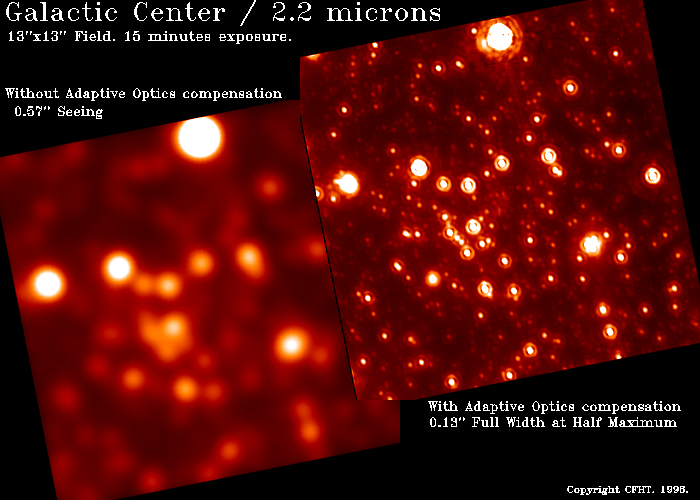
A Black Hole at the Center of our Galaxy
Credit: Image courtesy of F. Rigaut¹, R.Doyon², et al.
¹Gemini Observatory, Hawaii
²Université de Montréal, Canada

Is there a black hole or not at the center of our Galaxy? Chances are
the answer is YES!
Thanks to images like this week's CFHT picture, evidence is now
growing that there is indeed a massive "thing", a black hole, hiding
at the center of our Milky Way. Of course, a black hole cannot be seen
directly, by definition! But the object is so massive, and so small,
that there are traces of its presence. For example, stars located
close to the black hole have very rapid motions, they rapidly orbit a
point in space where... we see nothing! It is these rapid motions that
hint at the presence, and position, of a black hole at the center of
our Galaxy.
This week's image shows, on the left hand side, the galactic center as
it is seen by a telescope located in a good site (atop Mauna Kea for
example) using normal imaging techniques. The right image shows the
same field, as seen with the Canada-France-Hawaii Telescope Adaptive
Optics system. The image is crisper, and a lot of details and new
stars stand out. Note the diffraction rings around each star, which
indicate that the ultimate resolving power of the telescope has been
reached.
This image (not deconvolved) revealed the center of our galaxy with
new details that allowed a team at CFHT, University of Montreal and
the Dominion Astronomical Observatory (Victoria, Canada) to put new
constraints on the central engine of our Galaxy. A very dense core,
most probably a black hole, is believed to lie approximately at the
center of this stellar field. The motion of some stars close to where
the black hole is thought to be located have apparent velocities in
excess of 2000 kilometers per seconds!
The image on the right was obtained with PUEO, the Adaptive Optics
system of the Canada-France-Hawaii Telescope. A wide near-infrared
filter centered at a wavelength of 2.2microns was used. This image
was obtained in 1995 with MONICA, the MOntreal Near-Infrared Camera.
The total field of view is only 13 X 13 arcseconds. The total integration time on this field was 15 minutes.
Note the little "circle" around each star. It is called an "Airy ring"
and it is a feature typical of images that are at the diffraction
limit of a telescope. They indicate that the images have the best
sharpness the telescope can do!
Technical description:



